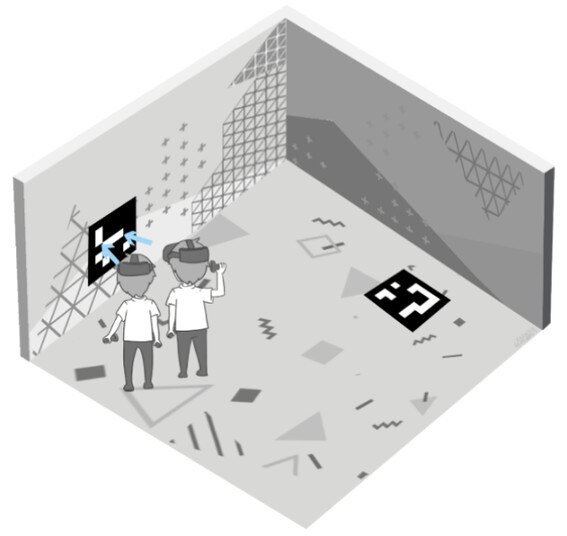-
简介
-
追踪模式
-
ArUco 标记和基于标记的追踪功能
-
基于标记的追踪功能
-
-
基于标记的位置共享设置
-
LBE 模式/LBE 混合模式设置
-
LBE 地图配置
-
基于标记的防漂移设置
-
基于标记的高级重新定位设置
-
基于标记的场景对齐设置
-
VR 模拟器模式设置
-
其他服务
-
更多功能
设置基于标记的位置共享
为基于标记的位置共享创建 ArUco 标记,并在游玩区进行设置。
本主题介绍如何为一体机设备设置基于标记的位置共享。使用 PC VR 头戴式设备进行基于标记的位置共享需要额外的步骤。有关在 PC VR 中使用基于标记的位置共享的详细信息,请参见使用 VIVE Business 串流设置基于标记的位置共享。
注:
- 基于标记的位置共享只能与登记了 VO 模式的头戴式设备配合使用。
- 您可以将一个或两个 ArUco 标记与基于标记的位置共享配合使用。
- 当使用两个 ArUco 标记设置基于标记的位置共享时,游玩区应至少为 150 平方米。
- 设置要在游玩区使用的头戴式设备。请参见设置头戴式设备。
- 创建您的 ArUco 标记。请参见为基于标记的位置共享创建 ArUco 标记。
- 使用基于标记的位置共享 API 配置您的虚拟现实应用程序。有关详细信息,请参见基于标记的位置共享 API(一体机)。
- 可选:设置虚拟场景的追踪原点。这将用于根据您创建的标记的高度对齐虚拟场景的高度。有关详细信息,请参见使用 ArUco 标记对齐虚拟场景的高度。
- 将主要标记放置在游玩区的中心位置。您可以将其放在地面或墙上,只要清晰可见即可。
- 如果您使用的是两个标记,请将次要标记放置在游玩区。请确保其与主要标记至少相距 150 厘米。
- 将头戴式设备带入游玩区并戴上。头戴式设备应从待机模式唤醒。
-
扫描主要标记。扫描时请确保站直并保持头部不动。

-
如果您使用的是两个标记,请扫描次要标记。
位置共享将自动开始。每个玩家的位置将由头戴式设备的追踪引擎对齐。
提示: 如果您在位置共享开始后失去追踪,请尝试向前后移动以恢复追踪。如果追踪没有立即恢复,请再次扫描 ArUco 标记以重置您的位置。 注:
注:- 在扫描一个或两个标记(取决于您的设置)后,头戴式设备上的标记检测将被禁用。您可以使用扫描标记 API 重新启用标记检测。
- 当您在游玩期间退出应用程序时,位置共享将停止,您的位置也将重置。您可以在重新打开应用程序后使用继续位置共享 API 继续位置共享。
有关详细信息,请参见基于标记的位置共享 API(一体机)。
此内容对您有帮助吗?
是
否
提交
谢谢!您的反馈可以帮助其他人了解最有用的信息。